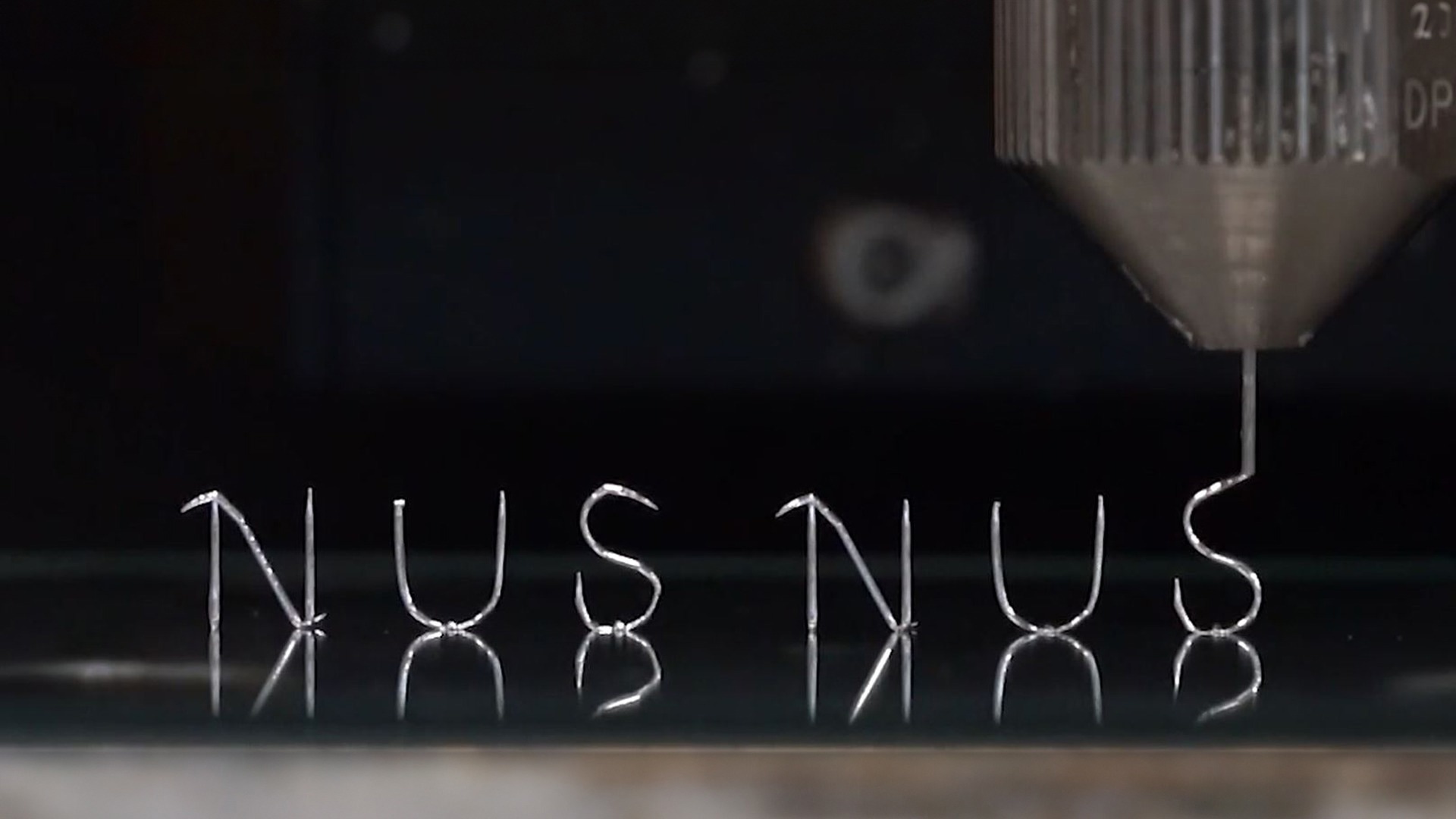Reviewed by Lexie CornerJul 30 2024
A research team led by Associate Professor Benjamin Tee from the Department of Materials Science and Engineering in the NUS College of Design and Engineering used Field’s metal to show how CHARM3D can fabricate a variety of electronics, enabling more compact designs in gadgets like electromagnetic metamaterials, wearable sensors, and wireless communication systems. This research was published in Nature Electronics.
 CHARM3D, developed by researchers from the NUS Department of Materials Science and Engineering, is able to print free-standing metallic structures without the need for support materials and external pressure. This new technique fabricates 3D electronic circuits faster and with greater level of detail and accuracy. Image Credit: National University of Singapore
CHARM3D, developed by researchers from the NUS Department of Materials Science and Engineering, is able to print free-standing metallic structures without the need for support materials and external pressure. This new technique fabricates 3D electronic circuits faster and with greater level of detail and accuracy. Image Credit: National University of Singapore
In contrast to conventional printed circuit boards, which are flat, 3D circuitry allows components to be stacked and incorporated vertically—significantly reducing the footprint needed for devices.
A group of researchers from the National University of Singapore (NUS) have advanced the field of 3D printed circuits by creating 3D, self-healing electronic circuits using a cutting-edge method called tension-driven CHARM3D. This innovative method allows free-standing metallic objects to be 3D printed without external pressure or support materials.
For example, CHARM3D makes it easier to design contactless vital sign monitoring devices for the healthcare industry, which improves patient comfort and allows for continuous monitoring. Optimizing the performance of 3D antennas in signal sensing can lead to stronger security applications, more precise medical imaging, and better communication systems.
The study’s corresponding author is Associate Professor Tee.
A More Streamlined Approach to 3D Circuit Manufacturing
Modern electronics, including robots, robotics, and sensors, increasingly depend on 3D electronic circuits to improve functionality and allow for further miniaturization. For instance, 3D structures increase sensor sensitivity and battery capacity due to their huge effective surface areas.
Direct ink writing (DIW) is a potential 3D printing approach currently utilized to build 3D circuits, but it has considerable limitations. The key is using composite inks, which include support components to help with solidification after printing but have poor electrical conductivity. Additionally, the inks’ excessive viscosity hinders printing speed.
Field's metal is a eutectic alloy composed of indium, bismuth, and tin. Eutectic alloys melt and freeze at a single temperature lower than the melting temperatures of their constituent metals, making them an appealing alternative material for 3D printing.
Unlike composite inks, Field’s metal hardens quickly, allowing the printing process to avoid support materials and external pressure. It has a low melting point of 62 degrees Celsius, good electrical conductivity, and low toxicity.
The CHARM3D technique uses the low melting point of Field’s metal to exploit the tension between molten metal in a nozzle and the leading edge of the printed part. This results in uniform, smooth microwire structures with adjustable widths of 100 to 300 microns, roughly the width of one to three strands of human hair. Critically, CHARM3D lacks phenomena like beading and uneven surfaces, which are common in pressure-driven DIW.
CHARM3D enables quicker printing speeds of up to 100 millimeters per second and better resolutions than conventional DIW, allowing for greater intricacy and precision in circuit construction.
CHARM3D eliminates post-treatment procedures and creates sophisticated free-standing 3D structures such as vertical letters, cubic frameworks, and scalable helixes. These 3D designs have good structural retention and self-healing properties, which means they can recover from mechanical damage and are recyclable.
By offering a faster and simpler approach to 3D metal printing as a solution for advanced electronic circuit manufacturing, CHARM3D holds immense promise for the industrial-scale production and widespread adoption of intricate 3D electronic circuits.
Benjamin Tee, Associate Professor, Department of Materials Science and Engineering, National University of Singapore
Far-Reaching Applications
The researchers successfully printed a 3D circuit for wearable temperature sensors that do not need batteries, antennas for wireless vital sign monitoring, and metamaterials for electromagnetic wave manipulation, demonstrating the variety of applications made possible by CHARM3D.
Conventional hospital equipment like pulse oximeters and electrocardiograms require skin contact, which can be uncomfortable and increase the risk of infection. Using CHARM3D, contact-free sensors may be included in smart clothing and antennae, enabling continuous, precise health monitoring in homes, assisted living institutions, and hospitals.
Furthermore, arrays of 3D antennas or electromagnetic metamaterial sensors created using CHARM3D might improve signal detection and processing applications. This results in enhanced signal-to-noise ratios and wider bandwidths.
The technique paves the way for the development of specialized antennas for targeted communication, as well as more accurate medical imaging, such as microwave breast imaging for early tumor detection, and advanced security applications, such as detecting hidden devices or contraband that emit specific electromagnetic signatures.
Dr. Zhuangjian Liu of the Agency for Science, Technology, and Research's Institute of High-Performance Computing and Professor Michael Dickey of North Carolina State University’s Department of Chemical and Biomolecular Engineering are collaborators on this study.
Next Steps
The study team hopes this process can be applied to various types of metals and structural applications. The team is also exploring ways to commercialize this novel technique to metal printing.
NUS researchers develop a novel technique to fabricate 3D circuits for advanced electronics
Video Credit: National University of Singapore
Journal Reference:
Ling, S., et al. (2024) Tension-driven three-dimensional printing of free-standing Field’s metal structures. Nature Electronics. doi:10.1038/s41928-024-01207-y